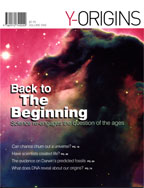THE MYSTERY OF CONSCIOUSNESS
The cerebral cortex is the area of our brains where, mysteriously, “matter is transformed into consciousness.”23 The cerebral cortex distinguishes human beings from all other animals. “Though the difference between the human genome and that of a chimp is estimated to be less than 1 percent, our cerebral cortex has ten times more neurons.”24 But that is not the total story. Mayr reveals, “The unique character of our brain seems to lie in the existence of many (perhaps as many as forty) different types of neurons….”25 And in spite of the DNA similarities, between humans and chimpanzees, there are still some 40 million differences.26
Additionally, recent studies have shown that chimpanzees lack awareness of their own thoughts, a trait that appears to be uniquely human. 27
Awareness of thoughts is something that is beyond our ability to create, even in the most sophisticated software programs. When chess Grandmaster Gary Kasparov was defeated by the IBM supercomputer, Deep Blue, the computer didn’t even realize it had won. Deep Blue lacked this self-awareness we take for granted. It is called consciousness, a mystery that has baffled philosophers and scientists for centuries.
Our awareness, with its manipulation of ideas, actually takes place in the prefrontal cortex.28 It is here that we reason, ponder, imagine, fantasize, and seek answers to why we exist. This prefrontal cortex area in a human makes up a far larger proportion of the cerebral cortex than in any animal, and it is the most complex arrangement of matter in the universe.29
If we could shrink in size and become spectators to the incredible activity in the innermost portion of the cerebral cortex, we might see something resembling a kaleidoscope of fireworks networking in all directions. Yet these electrical impulses are billions of organized patterns that result in our thoughts and imaginations. All of these thoughts intersect with our self-awareness.
While consciousness is at rest during sleep, the brain is still in action. “Even in sleep, the brain is pulsing, throbbing and flashing with the complex business of human life—dreaming, remembering, figuring things out. Our thoughts, visions and fantasies have a physical reality.”30
Nobody really understands consciousness or how we got it. Sir John Maddox, former editor-in-chief of the journal Nature, addresses the puzzle of consciousness: “Nobody understands how decisions are made or how imagination is set free. What consciousness consists of, or how it should be defined, is equally puzzling. … We seem as far from understanding cognitive processes as we were a century ago.”31
For years materialists have tried to reduce humans to nothing more than a series of drives and instincts.
However, in reality human consciousness chooses between the instincts, and it is as different and separate from them as the pianist is from the keys he chooses to play on the piano. The consciousness sits over and above our instincts, drives, and desires, and it chooses which it will act upon.32
Thus, man can choose to disregard his own desire to survive for a higher purpose. Such an act of heroism works counter to Darwin’s survival of the fittest, and is unexplainable by materialists. There seems to be something about consciousness that transcends self-preservation.
Another example of consciousness is the objectivity of the self—you distinguish yourself from your experiences. When stimulated, you distinctly feel that pain or pleasure is happening to you and that you are distinct from the experience causing the pain or pleasure. It is this objective awareness of our own thoughts that appears to be unique to human beings.
So difficult is the problem posed by our consciousness that Laurence C. Wood said, “Many brain scientists have been compelled to postulate the existence of an immaterial mind, even though they might not embrace a belief in life after death.”33
What process in natural selection could have led to human consciousness? Although evolutionists have taken a stab at it, no one really knows. Neither do scientists have an explanation for human imagination or creativity.
In human beings, the ability to simulate alternative future events appears to take place within our subjective consciousness. Oxford zoologist Richard Dawkins admits that nothing in Darwinian evolution accounts for it. Although Dawkins remains an ardent materialist, he writes, “Why this should have happened is to me, the most profound mystery facing modern biology.”34
Even leading evolutionist Stephen J. Gould recognized the inability of natural selection to explain the human brain. Gould admitted, “I don’t know why the brain got large in the first place. It certainly wasn’t so that we could paint pictures or write symbols.”35
Back | Endnotes | Next
|




